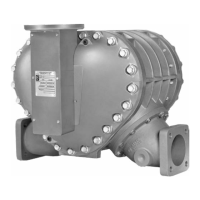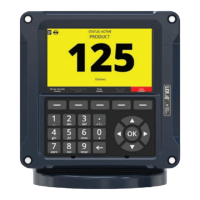TROUBLESHOOTING TROUBLESHOOTING & REPLACEMENT PARTS
1. Refer to the exploded view drawings on pages 24-27. Find the four-digit item number of the part that needs replaced. Item
numbers are listed on the exploded drawings.
2. In the red Owner’s Information Packet supplied with the meter, you will nd a computer printout titled Parts List. The Parts
List lists each item number alongside a ve-digit part number. The part number identies the specic individual piece, kit, or
complete assembly used to assemble that particular meter.
3. Contact your distributor and give them the ve-digit part number. Your
distributor will use it to nd the correct component for your meter.
Always check www.lcmeter.com for
the most current version of manual
M610 - Bill of Materials for LC meters.
PROBLEM PROBABLE CAUSE & SOLUTION
Leakage past packing gland
drive shaft housing from
internal metering chamber
Internal seal of packing gland assembly is worn. Replace packing gland and
O-ring seal.
OPERATING NOTE
Two common causes of packing gland leakage are thermal expansion and hydraulic shock.
Thermal expansion can occur when two valves in a piping system, on either side of the meter,
are closed at the same time and the temperature in the system rises. As little as a 1°F increase
in temperature can drive the system pressure to a point that exceeds the maxiumum working
pressure rating of the meter. To avoid any damage caused by thermal expansion, a pressure-
relief valve of some kind must be installed in the system.
Hydraulic shock occurs when a large volume (mass) of liquid is owing through the system
and a valve suddenly closes. When the ow is stopped, the entire mass of the liquid in the
piping system rams into the components within the meter. The greater the length of line (more
line length equals more liquid mass) and the greater the velocity of the liquid, the greater the
hydraulic shock. Since the valve is usually located at the meter outlet, the meter housing,
packing gland and the meter internal are subject to the full impact of such hydraulic shock. To
prevent hydraulic shock, a slow closing two-stage valve should be used with the meter. On
systems where mass length of line and velocity are of a magnitude that preclude the elimination
of hydraulic shock with the use of a two-stage slow closing valve, an impact-absorbing air
cushioning device can be added to further dampen hydraulic shock.
Leakage from the cover
gasket
Gasket has been damaged due to shock pressure or cover bolts have not been
tightened sufciently. Replace gasket and tighten cover bolts correctly.
Product ows through
meter but the register does
not operate
A. Check packing gland, and gear train.
B.
If all meter parts are moving then problem is in register. Faulty register should
be checked and repaired by trained mechanic.
C.
Remove register from meter. If all meter parts are moving but output shaft of
adjuster assembly is not, adjuster is worn and must be replaced.
D.
If totalizer numerals (small numbers) on register are recording, but the big
numerals are not moving, register needs repair.
E.
Packing gland gear not turning. Replace the packing gland. This may be
caused by starting the ow too rapidly.
For M-60 and M-80 meters, the drive blade may be sheared.
Breaking teeth on timing
gears
A. Starting or stopping ow in meter too rapidly.
B. Pump bypass not adjusted properly.
PROBLEM PROBABLE CAUSE & SOLUTION
Product ows through
meter but register does not
record correctly
A. Adjuster not properly calibrated.
B. Incorrect gear plate or gear ratio has been installed.
C. Air is in the system.
No ow through meter
A. Faulty non-functioning pump.
B. Valve not open or not functioning.
C.
Meter “frozen” due to build-up of chemical “salts” or foreign material inside
metering chamber. Clean the meter and inspect for damage.
Meter runs too slowly
A. Valve internal mechanism faulty. Valve does not open fully.
B.
Meter gears or rotors partially “salted” enough to slow up rotation of parts.
Clean the meter.
C. Downstream restriction.
D. Clogged strainer basket.
The meter counts down in
reverse (the meter numbers
decrease)
Reverse the direction of ow by reversing the adjuster drive gear. See
Reversing the Meter Registration on page 10.
23
22

